I've been having a ball getting reacquainted with single-ended-triode (SET) amplifiers.
Over the past few decades I've owned numerous SET amplifiers built around 45, 2A3, 300B, and 845/211 vacuum tubes. They were all unique and all had their desirable traits, and I really enjoyed my time with them.
I can tell you for sure that the SET amplifier designs I've been listening to of late are in a different performance category from those I've owned previously.
It seems to me like SET amplifier designs are maturing closer to their full potential, due to the very high-quality transformers available, the very high-quality of capacitors, resistors, etc., used in their circuits, and of course the continual refinement of the circuits themselves, in terms of power supplies, input and driver stages, and other design elements.
I installed the Audio Note (UK) Meishu Phono Silver Tonmeister 300B SET integrated amplifier into my vintage Altec A5 Voice of the Theatre loudspeakers based audio-visual system, in place of the Audio Note (UK) Oto Phono SE Signature integrated amplifier (below), that I wrote a long term report about HERE.
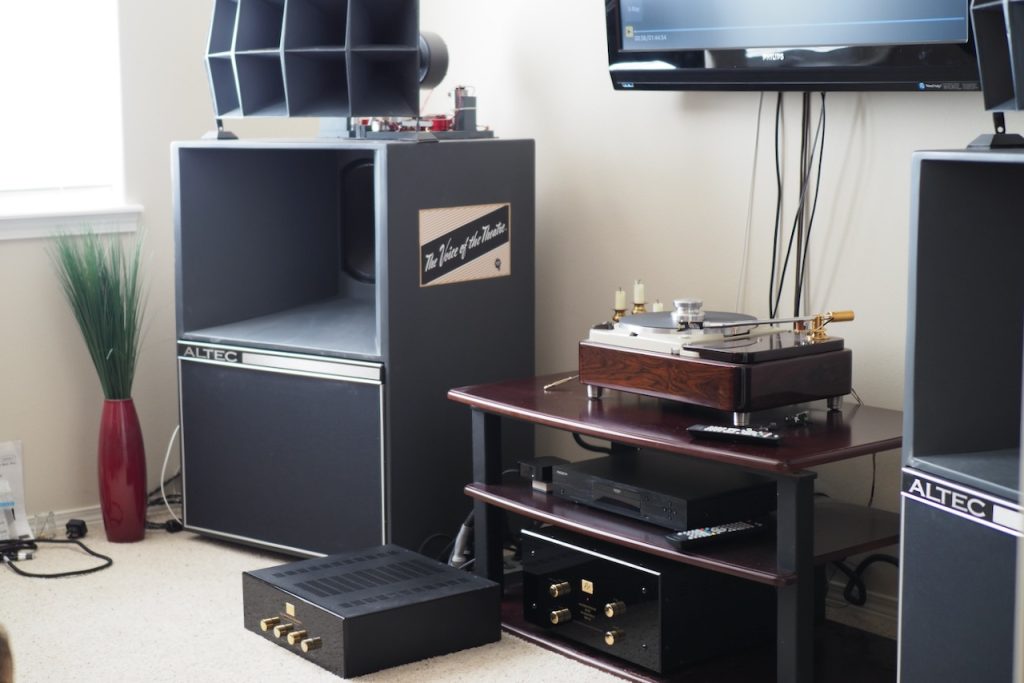
Audio Note (UK) Oto and Meishu integrated amplifiers with the vintage Altec A5 Voice of the Theatre loudspeakers.
If you haven't yet read the long term report on the Oto, I recommend you do, as I go into detail about the Altec A5 loudspeakers, their crossovers, positioning, etc., and what a great match the Oto is to my vintage Altec loudspeakers.
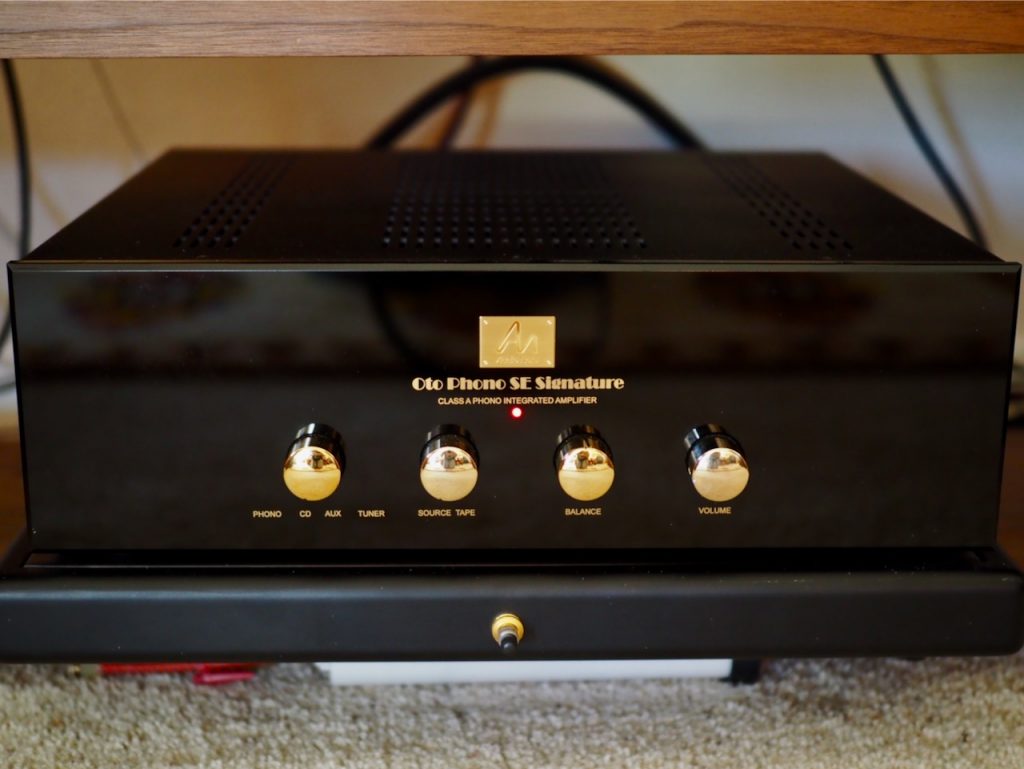
The Audio Note (UK) Oto Phono Signature integrated amplifier.
To catch up on the Oto story you can also read the Positive Feedback feature review of it HERE in Issue 108.
For an overview of the Audio Note (UK) Meishu Phono Silver Tonmeister 300B SET integrated amplifier, you can read my Today's Fresh Catch article about it HERE.
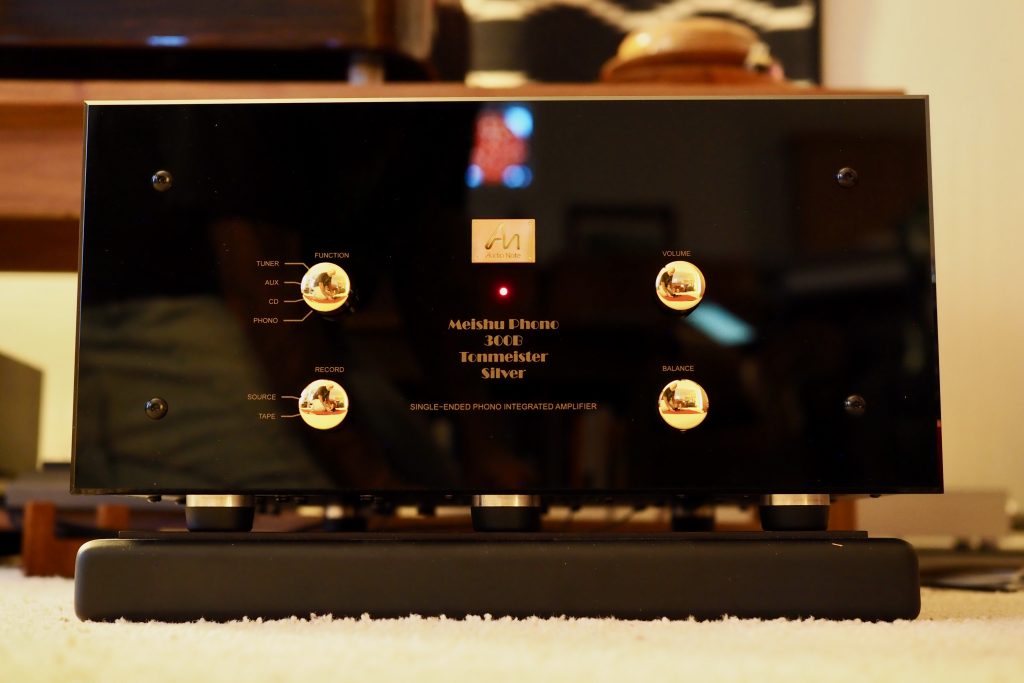
Audio Note (UK) Meishu 300B Phono Silver Tonmeister integrated amplifier.
The Audio Note (UK) Oto Phono SE Signature integrated amplifier is a Level 2 integrated amplifier in the Audio Note (UK) 'performance level system', and the Audio Note (UK) Meishu Phono Silver Tonmeister 300B SET integrated amplifier is a Level 3 integrated amplifier.
Level 2 integrated amplifiers, like the Audio Note (UK) Oto Phono SE Signature integrated amplifier, for example, are "Class A single-ended pentode or tetrode amplifiers & Class A push-pull directly heated no-feedback triode amplifiers".
Level 3 integrated amplifiers, like the Audio Note (UK) Meishu Phono Silver Tonmeister 300B SET integrated amplifier, and the Audio Note (UK) Jinro 211 SET integrated amplifier, for example, are "Class A single-ended directly heated no feedback triode amplifiers".
So what is the difference between Level 2 and Level 3 in terms of cost? It's a lot.
For example, the Audio Note (UK) Oto Phono SE Signature Level 2 integrated amplifier's current price is $7699 USD, the Audio Note (UK) Meishu Phono Silver Tonmeister 300B SET Level 3 integrated amplifier's price is $19,300 USD, and the Audio Note (UK) Jinro 211 SET Level 3 integrated amplifier is $32,060 USD.
So what is the difference between Level 2 and Level 3 in terms of build/performance? It's also a lot.
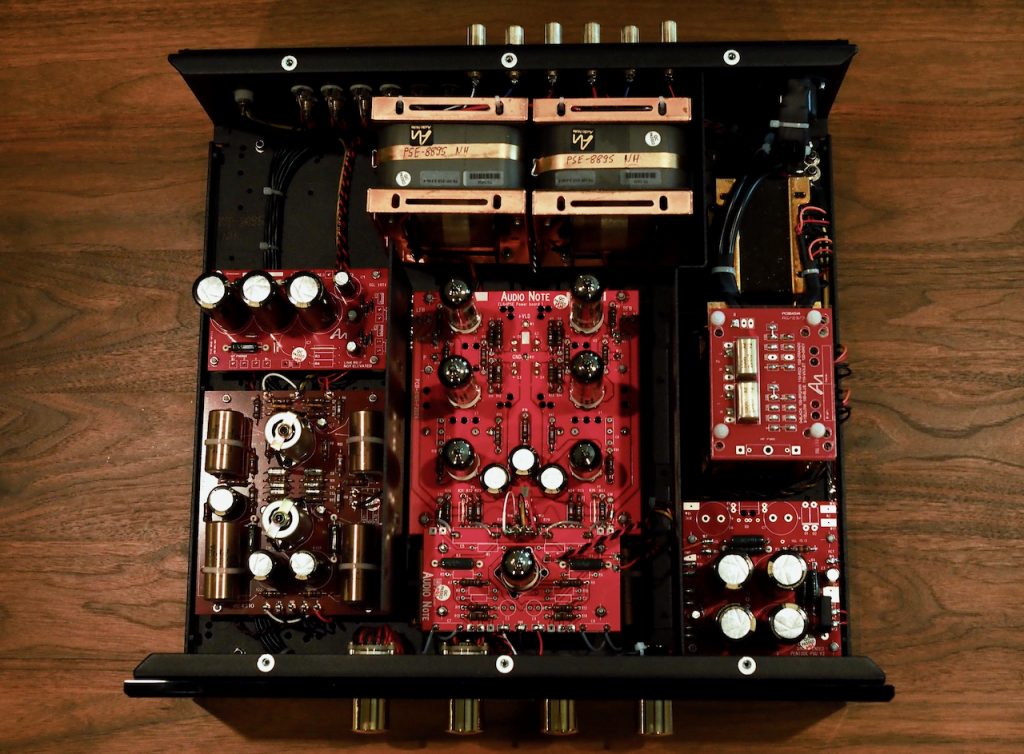
Inside the Oto.
Take for example the Audio Note (UK) Oto Phono SE Signature Level 2 integrated amplifier, with its EL84 parallel single ended pentode circuit, and its 10 watts of output power. The Oto is hand-crafted, built with excellent custom transformers that are built in house at Audio Note (UK), copper foil capacitors, and with dual power supplies (and transformers).
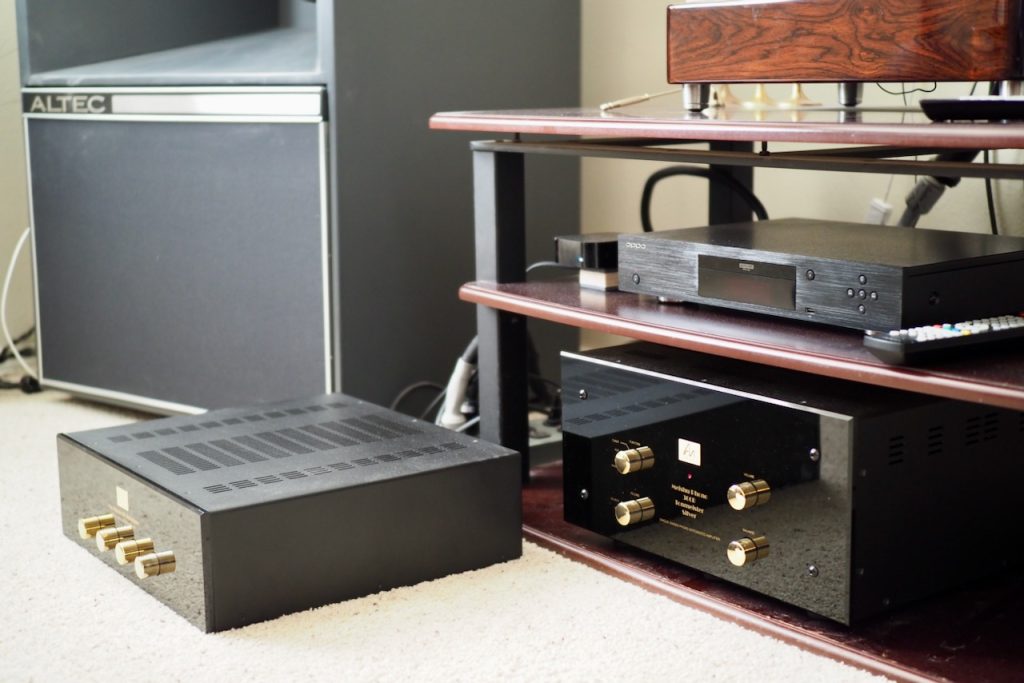
Oto (left) and Meishu (right)
Take a look at the photo above. The Audio Note (UK) Meishu Phono Silver Tonmeister 300B SET Level 3 integrated amplifier is twice the size of the Audio Note (UK) Oto Phono SE Signature Level 2 integrated amplifier.
The Oto weighs in at 17 Kg (37.5 pounds), and the Meishu weighs in at 29.5 Kg (65 pounds).
While size and weight aren't necessarily important metrics in themselves, it does hint that there is more going on inside the Meishu than the Oto, and that 'more' results in more cost and more performance.
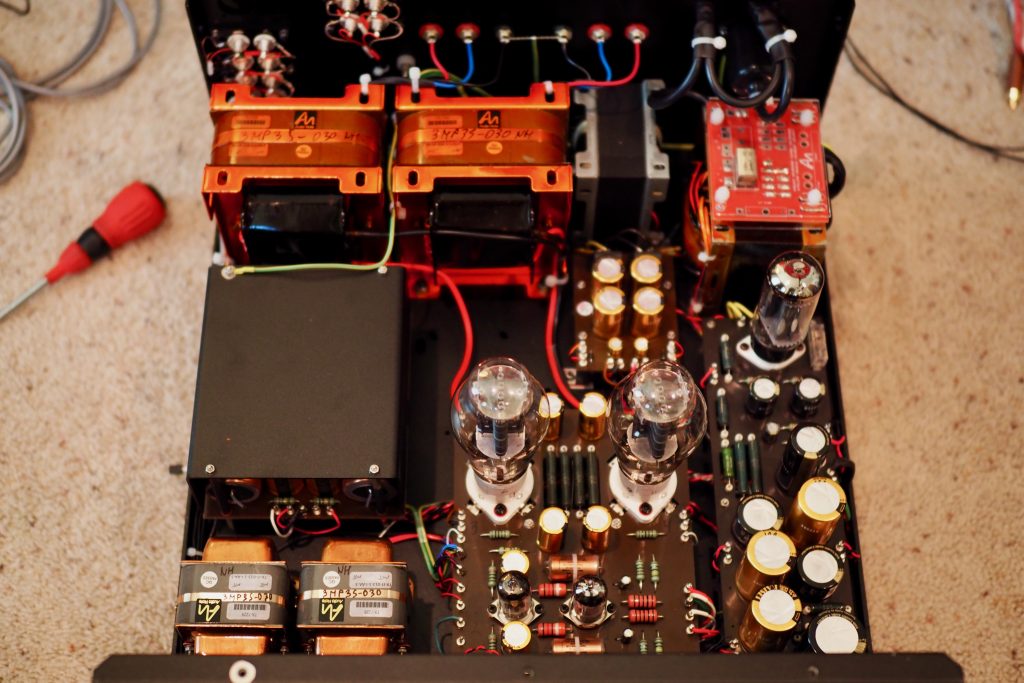
Topless Meishu 300B Phono Silver Tonmeister integrated amplifier.
The Audio Note (UK) Meishu Phono Silver Tonmeister 300B SET integrated amplifier utilizes a directly-heated single-ended-triode 300B circuit for 8 watts of power output.
The circuit is optimized around the classic 300B vacuum tube, with each part of its circuit optimized for maximum performance.
According to Audio Note (UK):
"The new PSU uses only one mains transformer, one 5U4 rectifier valve and one choke. When this arrangement is optimised, it works extremely well, producing a very homogeneous and ‘complete’ sound."
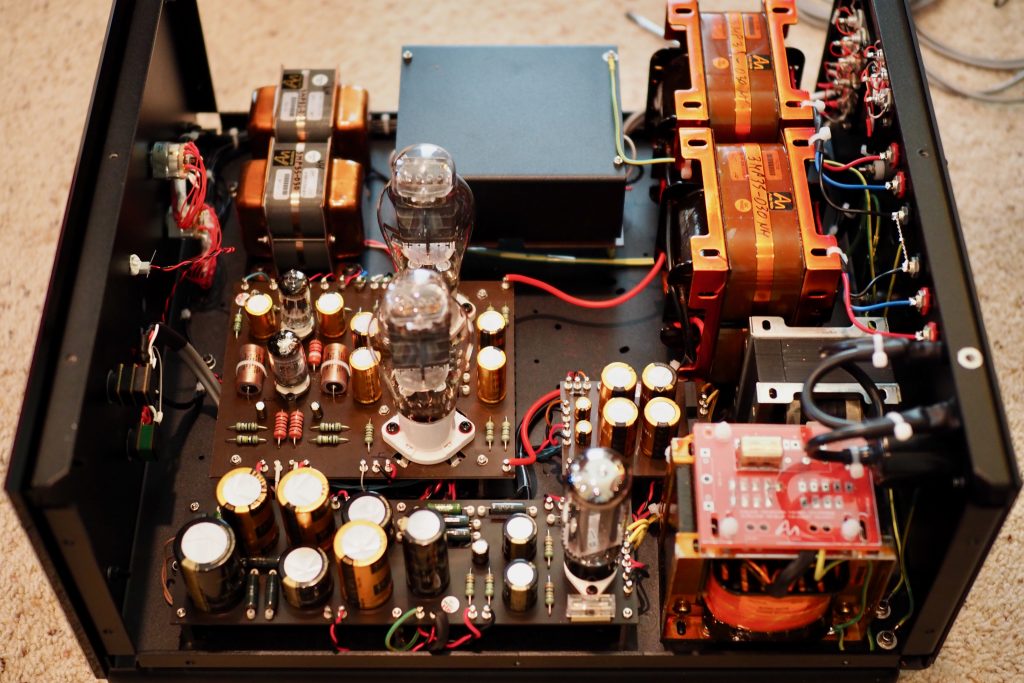
Inside the Meishu 300B Phono Silver Tonmeister integrated amplifier.
"The input and driver stage is very similar to that found in the Jinro, Tomei and Ongaku, with a 12AU7 and 5687 driving an in-house designed and manufactured inter-stage transformer for the best energy transfer, evenness and authority."

Meishu input and driver stage.
"The output transformers for the new Meishu were designed specifically for the project by Andy Grove, and it is not an overstatement to say that they are superb."
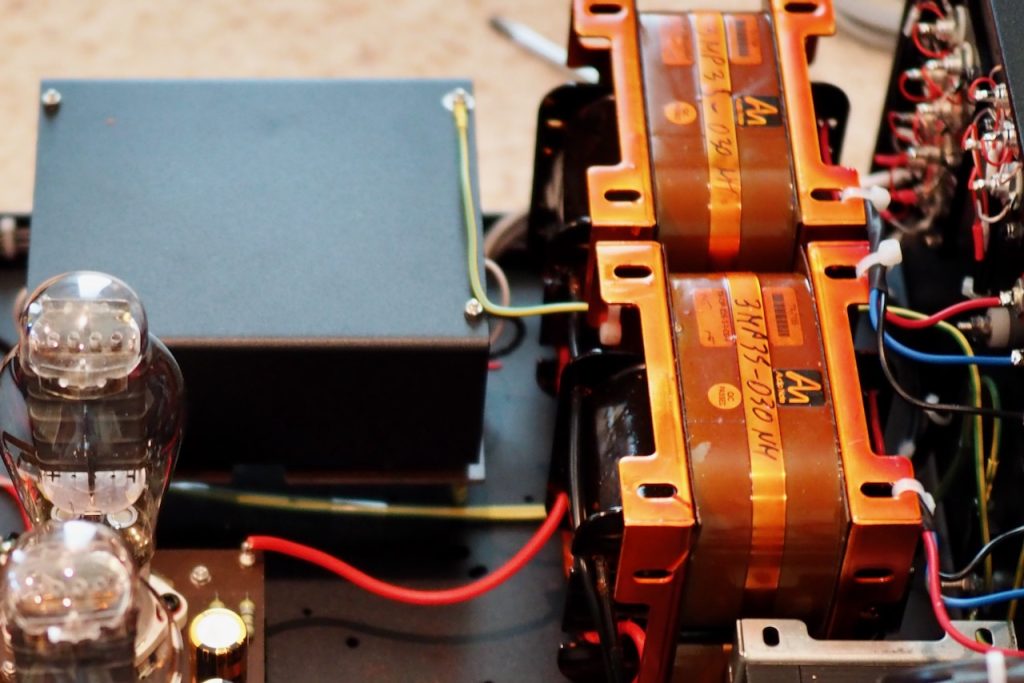
Custom Meishu output transformers.
"The circuit is now a beautiful example of elegant simplification, something that could only be realised thanks to our ability to create extremely closely matched transformers in-house, and having our own supply of custom resistors, in-house made foil capacitors and custom made electrolytic capacitors. These allow us to exert extremely tight control over the performance and voicing of the complete amplifier from input to output, something that is simply beyond the possibilities of manufacturers who have to rely on 'off the shelf' components."
"The result is an amplifier that maintains the legendary Audio Note musicality, midrange magic and glorious tonal colour of the original Meishu, whilst bringing new and previously unheard levels of information retrieval and dynamic expression, redefining what is usually expected of a 300B SET amplifier."
From a build standpoint, that's what the additional $11,601 USD in the price of the Audio Note (UK) Meishu Phono Silver Tonmeister 300B SET Level 3 integrated amplifier ($19,300 USD) buys you compared to the $7699 USD of the Audio Note (UK) Oto Phono SE Signature Level 2 integrated amplifier.
In the Audio Note (UK) integrated amplifier product line, the Audio Note (UK) Oto Phono SE Signature Level 2 integrated amplifier is one up from the entry level Audio Note (UK) I Zero integrated amplifier.
The Audio Note (UK) Meishu Phono Silver Tonmeister 300B SET Level 3 integrated amplifier sits in the middle of the integrated amplifier product line, and is the first step into directly-heated single-ended-triode integrated amplifier territory, and is Audio Note (UK)'s ultimate expression of a 300B SET integrated amplifier.
While the additional $11,601 USD in price of the Meishu over the Oto may seem like a lot, it really just reflects the more expensive costs associated with building a state-of-art 300B directly-heated single-ended-triode integrated amplifier.
I recently had a reader contact me about whether they should buy a Meishu or an Oto integrated amplifier. "Does the Meishu really perform at a higher level than the Oto? Is the extra cost justified?"
The answer is that, yes, the costs of the Meishu are directly proportional to its build costs, and it does definitely perform at a higher level than the Oto.
In the feature review of the Meishu for Positive Feedback, after I've had more time to compare the two integrated amplifiers directly, I'll offer more observations about their differences in performance.
The question about cost is a more personal one, and depends on how much a person can comfortably spend on audio equipment, and how much a person is willing to pay for that associated increase in performance.

Meishu phono stage.
One thing I haven't mentioned yet is the Audio Note (UK) Meishu Phono Silver Tonmeister 300B SET Level 3 integrated amplifier's phono stage (photo above).
As part of future Jeff's Place articles, and of course the feature article about the Meishu for Positive Feedback, I'll be telling you about how the Meishu's phono stage compares/differs from the Oto's phono stage, so more to come on that topic.
Note to self: Interview Andy Grove about the phono stage design in the Meishu.
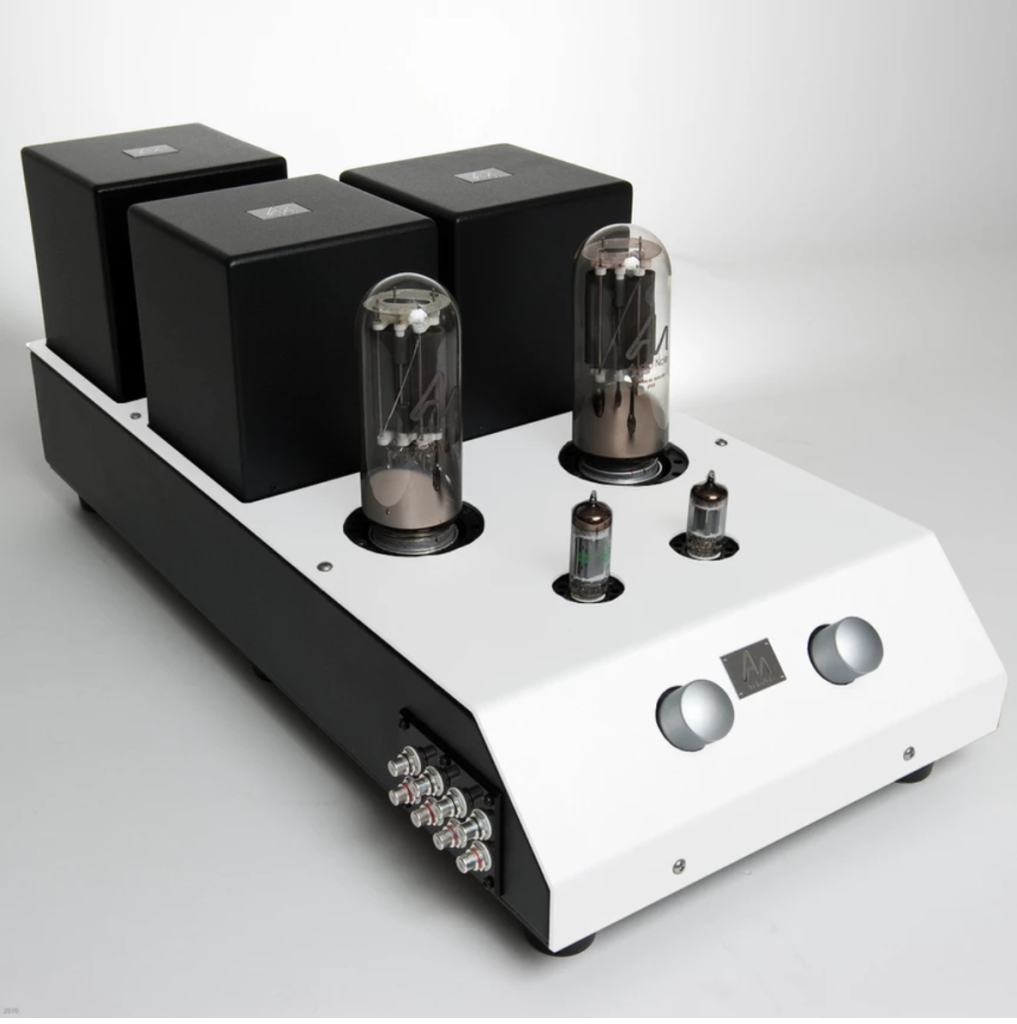
Level 3 Audio Note (UK) Jinro integrated amplifier.
I don't have a Level 3 Audio Note (UK) Jinro integrated amplifier here, but I wanted to mention the Jinro so I could give you an idea of where the Audio Note (UK) Meishu Phono Silver Tonmeister 300B SET integrated amplifier sits within the Audio Note (UK) hierarchy for integrated amplifiers.
I mentioned that in the Audio Note (UK) integrated amplifier product line, the Audio Note (UK) Oto Phono SE Signature Level 2 integrated amplifier is one up from the entry level Audio Note (UK) I Zero integrated amplifier, and that the Audio Note (UK) Meishu Phono Silver Tonmeister 300B SET Level 3 integrated amplifier is in the middle of the product line, being the first step into directly-heated single-ended-triode integrated amplifier territory.
The next step up in the Audio Note (UK) integrated amplifier product line is the Audio Note (UK) Jinro 211 SET Level 3 integrated amplifier ($32,060 USD).
While both the Meishu and Jinro are at Level 3 in the Audio Note (UK), the Jinro is the first step into the Jinro / Tomei / Ongaku directly-heated single-ended-triode 211 triode vacuum tube integrated amplifiers, has 20 watts of output power, and which represents Audio Note (UK)'s ultimate expressions of integrated amplifier performance.
So what does the extra $12,760 USD of the Audio Note (UK) Jinro 211 SET Level 3 integrated amplifier ($32,060 USD) get you over the $19,300 USD Audio Note (UK) Meishu Phono Silver Tonmeister 300B SET Level 3 integrated amplifier?
First, you get more single-ended-triode power with the Jinro (20 watts) than the Meishu (8 watts), and as with the extra cost of the Meishu over the Oto, the additional costs of the Jinro over the Meishu reflects the higher parts costs of building the Jinro.
You might note that when you get into the Jinro / Tomei / Ongaku integrated amplifiers, there is not an option for a phono stage to be built into the same chassis, as with the Oto and Meishu, so you will need to include in your budget the amount needed for a stand alone phono stage if you want a phono stage.
So in a nutshell, the Audio Note (UK) Oto Phono SE Signature Level 2 integrated amplifier represents entry into Audio Note (UK)'s product line of high-performance integrated amplifiers with a parallel EL84 single-ended-pentode circuit, the Audio Note (UK) Meishu Phono Silver Tonmeister 300B SET Level 3 integrated amplifier sits in the middle of the integrated amplifier product line and represents the first step into directly-heated single-ended-triodes with a 300B circuit, and the Audio Note (UK) Jinro 211 SET Level 3 integrated amplifier represents the first step into the top tier of Audio Note (UK)'s line of directly-heated 211 single-ended-triode integrated amplifiers.
The rise in price as you go up in the Audio Note (UK) integrated amplifier product line is commensurate with the increased costs associated with building the $19,300 USD Meishu 300B SET integrated amplifier compared to the $7699 USD EL84 based Oto (+$11,601 USD), and the increased costs of building a $32,060 USD Jinro 211 SET integrated amplifier compared to the Meishu 300B SET integrated amplifier (+$12,760 USD).
Listening to the Audio Note (UK) Meishu Phono Silver Tonmeister 300B SET Level 3 Integrated Amplifier
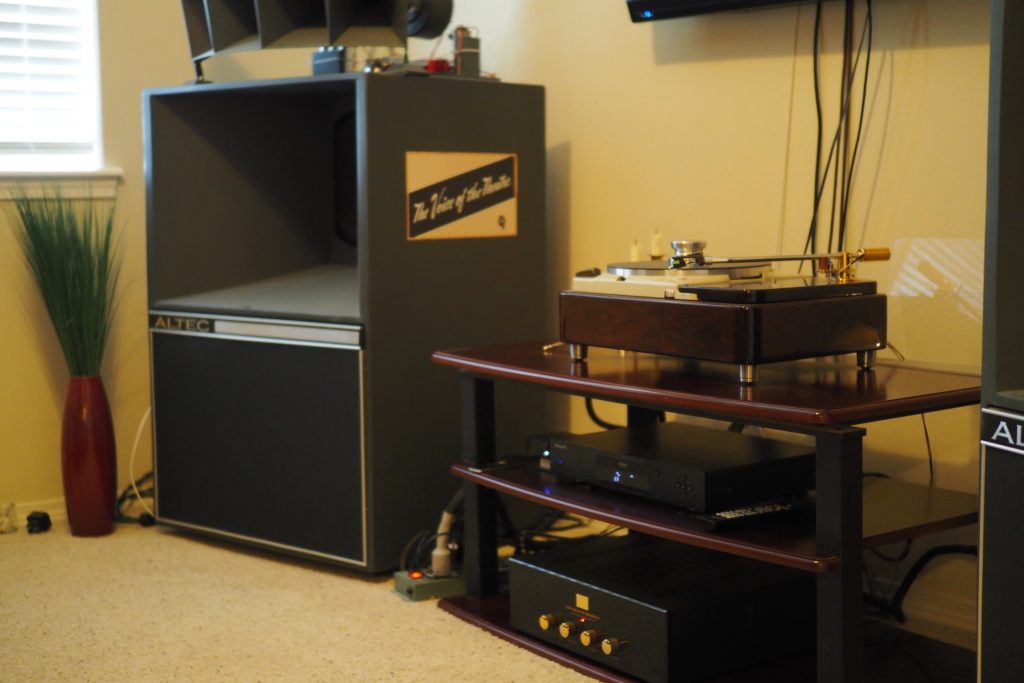
Vintage Altec A5 Voice of the Theatre loudspeakers with the Audio Note (UK) Oto Phono SE Signature integrated amplifier.
Ok, you already know I love the way the Audio Note (UK) Oto Phono SE Signature Level 2 integrated amplifier performs (photo above), so now lets listen to the Audio Note (UK) Meishu Phono Silver Tonmeister 300B SET Level 3 integrated amplifier in my vintage Altec A5 Voice of the Theatre loudspeakers based audio-visual system (photo below).

Audio Note (UK) Meishu Phono Silver Tonmeister 300B SET integrated amplifier with Altec A5 Voice of the Theatre loudspeakers.
Today I'm going to tell you about the Meishu in the context of video sources with my Altec A5 loudspeakers, and when I transition the Meishu into my Tannoy Westminster Royal SE loudspeakers music system, I'll tell you about its performance with Audio Note (UK) digital sources, and the Audio Note (UK) analog source combination of the Io I MC phono cartridge, AN-S4 step-up transformer, AN-V silver interconnects.
Just as a caveat, I want to mention that the Meishu is not fully "bedded-in yet". The owner's manual says, "The new amplifier requires roughly 200 hours of initial use (called “bedding in”) before the circuitry becomes stable and optimum performance is realized. As the amplifier “beds in” the sound will become increasingly smoother, detailed and open."
The Meishu only has about 50 hours on it at this point, so I expect its performance will continue to develop as described in the owner's manual as it gets more time on it.
I'll also tell you about the Audio Note (UK) Meishu Phono Silver Tonmeister 300B SET integrated amplifier's performance with the Audio Note (UK) AN-K/SPe loudspeakers that I mentioned in my Today's Fresh Catch post HERE, as soon as I can get that system setup (first with the Oto, then the Meishu).
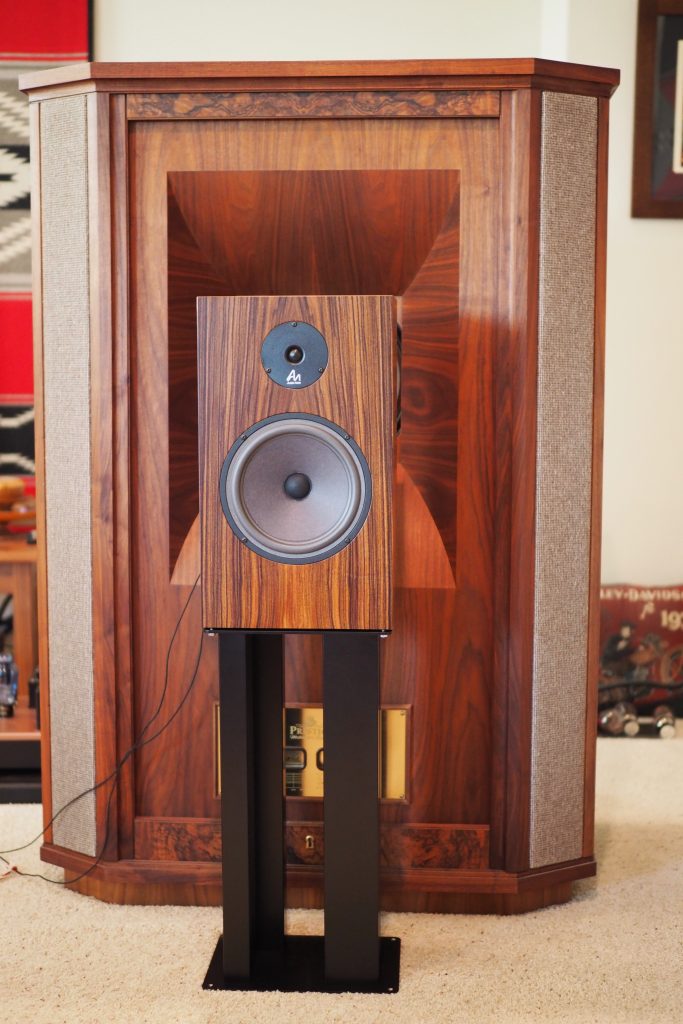
Audio Note (UK) AN-K loudspeakers are here!
The Audio Note (UK) AN-K/SPe loudspeakers based system will take me a little longer to get setup, as I have to move furniture out of my 'guitar practice room' into storage to make room, and then get the system setup.
One step at a time!

Sources are an Apple TV and Oppo UDP-203 Blu-ray disc player.
The system setup for my audio-visual system is exactly the same as I described in my long term report for the Oto (HERE).
For video sources I'm using the latest Apple TV for streaming duties, and an Oppo UDP-203 Blu-ray disc player for playing DVDs and Blu-ray discs (photo above).
I've really been looking forward to hearing my vintage Altec A5 Voice of the Theatre loudspeakers with the Audio Note (UK) Meishu Phono Silver Tonmeister 300B SET integrated amplifier.

I think everyone reading this knows that Altec A5 Voice of the Theatre loudspeakers powered by Western Electric 91-A 300B amplifiers were the heart and soul of small to mid-sized movie theaters in small-town North America, starting around 1945, and they can sometimes be found in small town movie theaters even today, quietly doing their duty in providing realistic voice, music, and foley components of film audio.
The Altec A5 and Western Electric 91-A 300B amplifier combination represented a revolution in sound quality for movie theaters back in those early days, and I love the performance of my vintage Altec A5 Voice of the Theatre loudspeakers today in my audio-visual system for their authentic movie theater 'listening experience'.
I'm almost embarrassed to say that I've never tried the classic pairing of a 300B amplifier with my A5s in my audio-visual system, and to be able to hear them with a state-of-art 300B integrated amplifier like the Meishu is a real treat for me.
The combination of Altec A5 loudspeakers with 300B SET amplification is how movies were ordained to be heard by the early cinema deities, and for good reason, as it is/was an addictive combination in terms of live-like tone, vivid aural presence, and impressive dynamics.
While I'm not ready to compare the Audio Note (UK) Meishu Phono Silver Tonmeister 300B SET integrated amplifier's performance with that of the Audio Note (UK) Oto Phono SE Signature integrated amplifier just yet, as its not fully bedded-in, but I can say that generally in terms of tone, presence, and dynamic sophistication the Meishu is a significant step up from the Oto.
I've also noticed that even with the room boundary positioning of my Altec A5s, there's much more of a sense of depth, width, and height in the presentation with the Meishu than for the Oto.
Aural images can extend outside the sidewall boundary planes of loudspeakers, can even be projected in front of the plane of the loudspeakers (!), as well as behind the plane of the loudspeakers, and even above the plane of the loudspeakers, in impressive room filling fashion.
Even when watching movies or television shows on streaming platforms like Amazon Prime or Netflix, the Meishu makes those shows sound remarkably immersive and engaging, with a sense of recorded ambience projected into and completely filling my audio-visual room - it's been just one of those ongoing "Wow!" experiences.
One thing I've noticed with the Meishu is that there is also a tremendous amount of foley information revealed. The Meishu is very resolving, and that makes everything feel more live-like and involving from an emotional perspective.
One of the things that many listeners love about SET amplification is how 'holographic' the aural images are, and with the Meishu it makes me feel like I can reach out and touch them because they sound so naturally 'real'.
Every element of the movie sound recording - voices, music, and film foley effects - has a very delineated position in the presentation, and its own associated ambience effect around it, making everything about the aural presentation very holographic.
For example, when big bass transients are present, there's a shimmering sense of acoustic space that extends out around the 'body' of the aural images, and the dynamic prowess of the Meishu makes those big bass hits come alive in a startling fashion that makes them feel very real.
One aspect of the Meishu's performance that has particularly impressed me is its ability to project aural images into my audio-visual room well outside the front plane of my Altec A5s. With other amplification components I would get a nice sense of ambience projected into the room from the A5s, but not individual images that make up the film sound.
With the Meishu aural images are projected significantly in front of my A5s for some film sound effects, and this is something new that I haven't experienced before with other amplification.
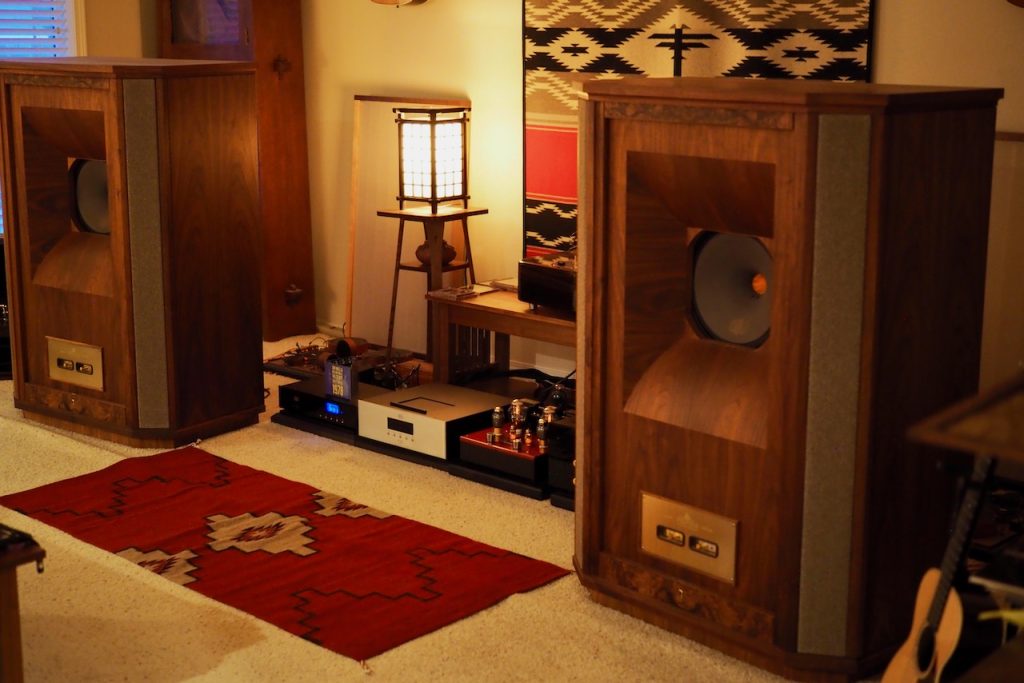
Westminster Roya SEs positioned 77 inches from the front wall, and 48 inches from the sidewalls.
This aspect deserves additional investigation.
For example, in my Westminster Royal SE loudspeakers based music system, they are arranged in audiophile-style positioning, with my West's being positioned well out into the room.
With this style of positioning what I've found is that the further out you place the loudspeakers into the room the more the depth perspective of the 'soundstage' is exaggerated/enhanced.
If you have a really big room and use a rule of thirds or rule of fifths positioning, the amount of holographic layering of images in the depth dimension can be remarkable for magnetic and digital era recordings.
What I don't really hear with this style of the audiophile positioning method is images placed significantly in front of the plane of the loudspeakers. Rather images are placed from the front of the loudspeakers back into the room towards the front wall, and sometimes behind the front wall.
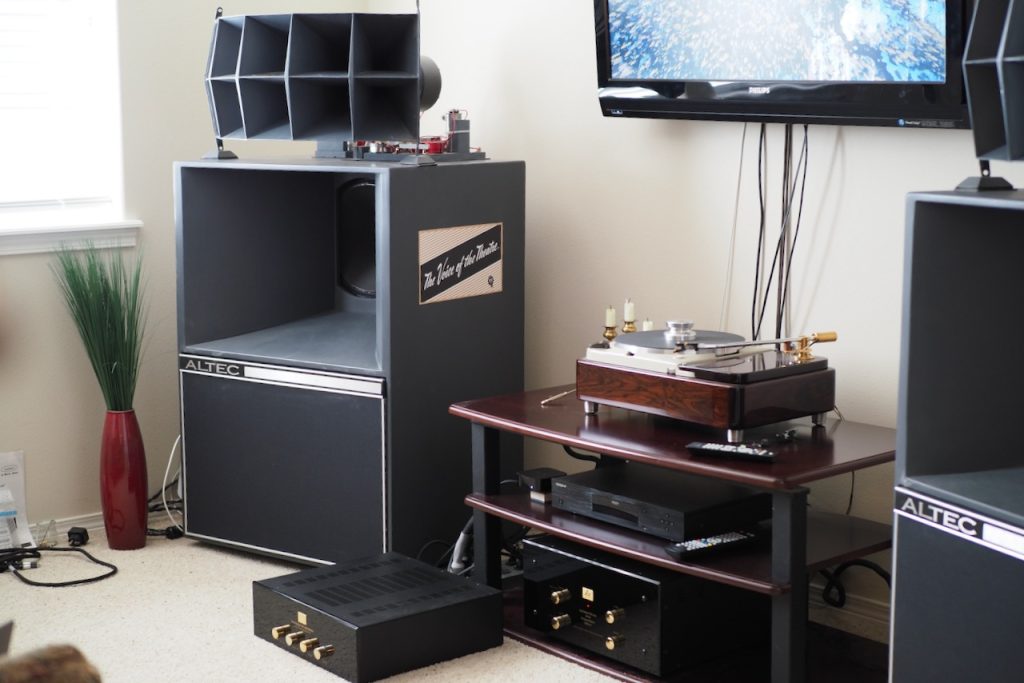
Altec A5 in room boundary positions (room corners).
So that makes what the Meishu is doing when projecting aural images into the room well in front of the room boundary position of my Altec A5s particularly intriguing.
That doesn't occur with all film sound recordings, but it does with quite a number of more recent film sound recordings, which I find fascinating.
What that suggests to me is that in newer film recordings there are recording artifacts of some type - perhaps a recording engineer could explain this phenomena - that results in aural images being placed well into the room in front of the loudspeakers.
I'll explore this further in the future as I notice more.
Ok, its time for me to wrap up my initial listening impressions post for the Audio Note (UK) Meishu Phono Silver Tonmeister 300B SET integrated amplifier.
The Audio Note (UK) Meishu Phono Silver Tonmeister 300B SET integrated amplifier has impressive levels of resolution, and I am hearing unprecedented levels of recovered information in film sound recordings for the elements of voices, music, film foley effects, and the sense of 'room ambience'.
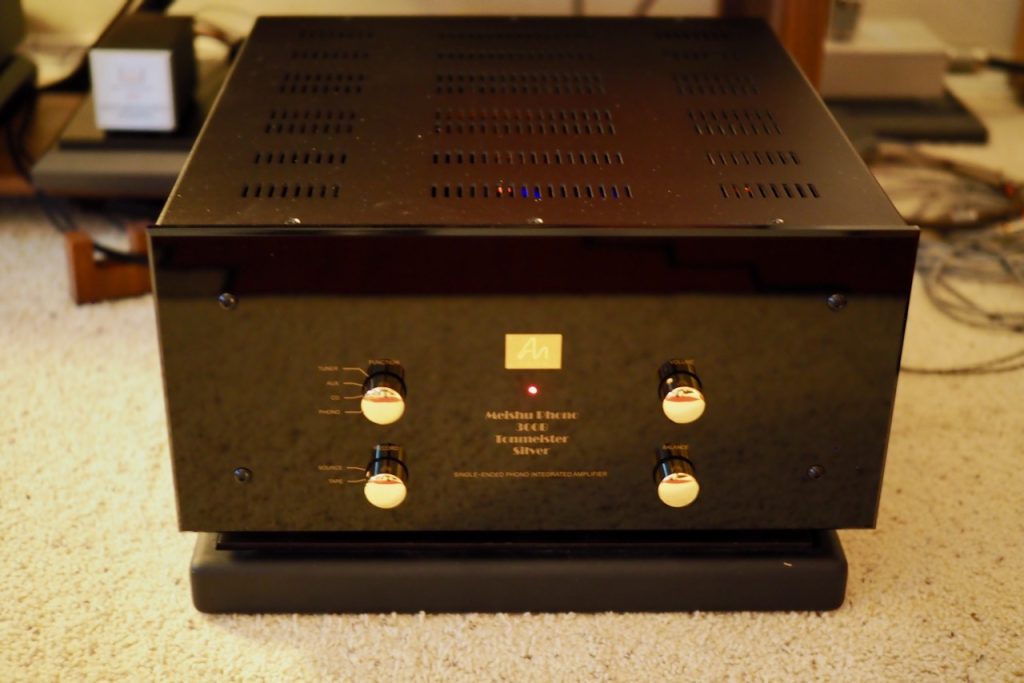
Audio Note (UK) Meishu Phono Silver Tonmeister 300B SET integrated amplifier.
The musical contributions to films are presented with a great deal of natural musicality, in a fashion that just sounds 'right' or 'real'. Those aspects of tone color, that you hear in jazz in particular, are very well resolved, making it easy to pick out major, minor, seventh, ninth, etc., and augmented and diminished chordal contributions to the music.
The Meishu also has that holographic SET-style of positioning of aural images in space with well a well-defined 'ambience' around them, which makes watching/listening to films more immersive and satisfying. Also, the Meishu is breaking new ground by placing images well in front of the plane of my Altec A5 loudspeakers, something that is new for me, and I find to be rather intriguing.
I also found that dynamic gradations from piano to fortissimo are reproduced in impressive fashion by the Meishu.
So for that trinity of factors of tone, dynamics, and presence that makes film sound recordings come alive to the listener, the Meishu does them all very, very well.
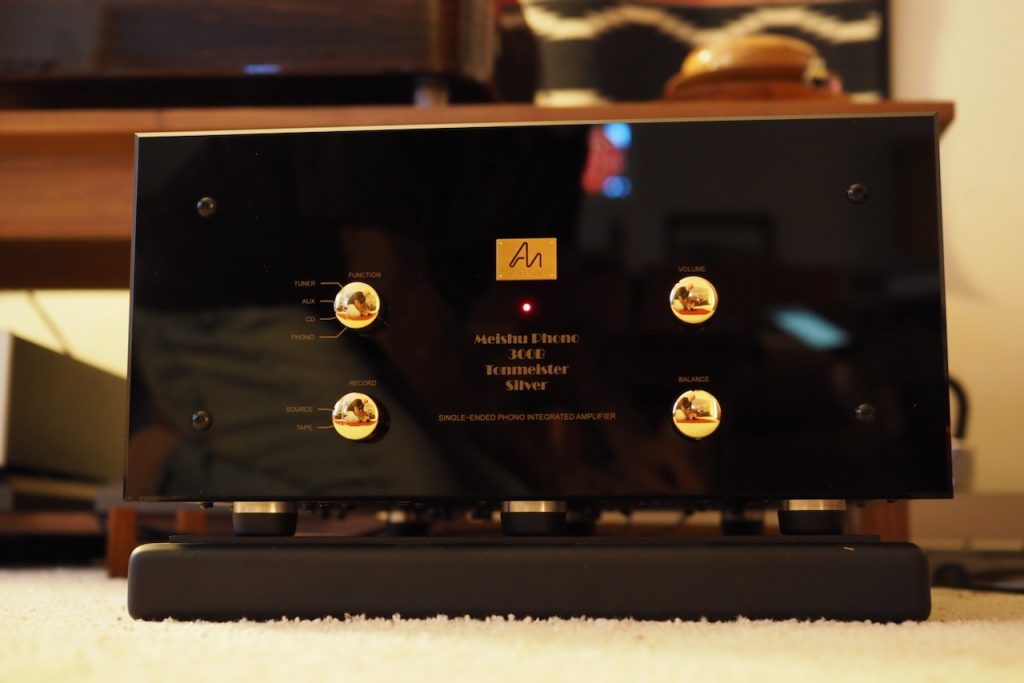
Audio Note (UK) Meishu Phono Silver Tonmeister 300B SET integrated amplifier.
I'm very impressed with what I'm hearing from the Audio Note (UK) Meishu Phono Silver Tonmeister 300B SET integrated amplifier, and I'll be looking forward to telling you more about it as it continues its "bedding-in" process to get to its full potential.
Much more to come about the Meishu!
As always, thanks for stopping by, and may the tone be with you!



























